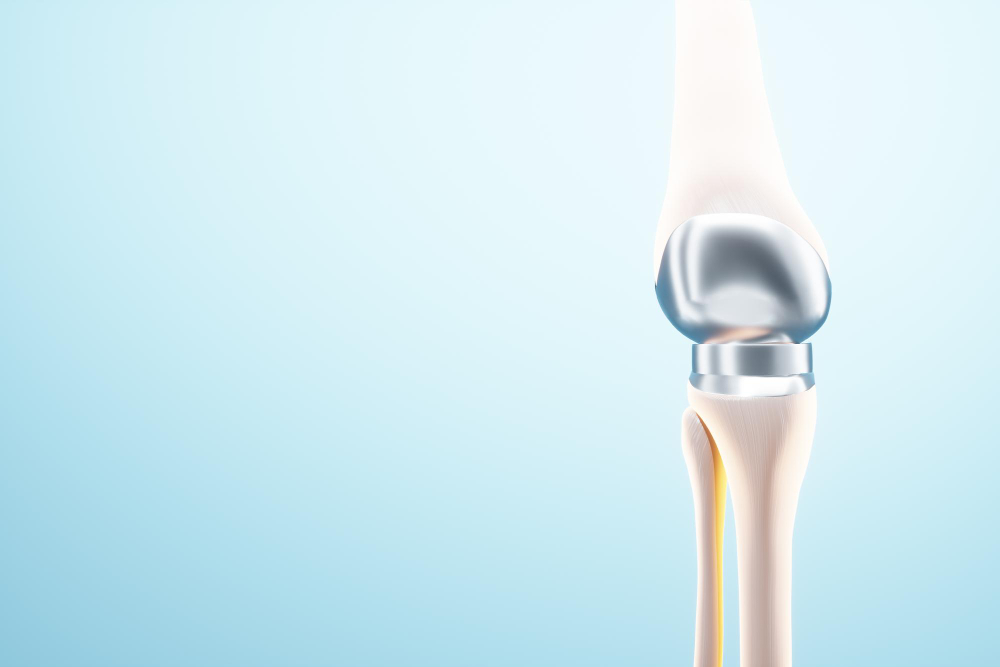What is a knee replacement surgery?
Knee replacement, also known as knee arthroplasty or total knee replacement, is a surgery conducted to restore a knee damaged by arthritis. The procedure involves covering the ends of the bones that shape the knee joint and the kneecap with metal and plastic parts. It is usually recommended for individuals who suffer from severe arthritis or a severe knee injury.

What materials are utilized in knee replacement implants?
The knee joint can be impacted by different forms of arthritis. Osteoarthritis is a deteriorative joint ailment that affects middle-aged and older individuals and can result in the loss of joint cartilage and surrounding bone in the knees. Rheumatoid arthritis causes the synovial membrane to become inflamed, leading to an excess of synovial fluid and resulting in discomfort and rigidity. Traumatic arthritis, which arises from injury, can harm the knee’s cartilage.
The objective of carrying out a knee replacement surgical procedure is to renew the damaged portions of the knee joint and alleviate knee discomfort that has failed to respond to other forms of treatment.
Which types of knee replacement surgeries are available?
There are two main types:
- In a total knee replacement procedure, the complete joint is substituted with synthetic materials.
- Partial knee replacement involves the replacement of only one specific damaged compartment of the knee, as opposed to a total knee replacement which involves replacing all compartments.
Out of these two procedures, total knee replacement is the one that is more frequently performed.
When to Consider Surgery
If other treatments for arthritis have failed and you are experiencing any of the following, then knee replacement surgery may be beneficial for you:
- You can’t walk very long or very well
- You can’t get in or out of a chair
- Your knee is bowed in or out
- Intense anguish felt when there is no physical activity.
The choice of knee replacement implant design and materials is unique to each patient. Typically, the key parts of the implant are constructed from metal, commonly titanium or chrome-cobalt alloys. The implants are secured either with cement or by osseointegration, which entails a perforated metal stem that extends into the tibia and the patient’s natural bone grows around it. A plastic spacer will be placed between the tibial and femoral implant surfaces, made up of polyethylene.
The majority of femoral parts are constructed from metal alloys such as cobalt chromium or metal-ceramic alloys containing oxidized zirconium. In contrast, the patellar component is composed of plastic in the form of polyethylene. The tibial insert component and tibial tray component are also constructed from polyethylene, while the tibial tray component can be made from a variety of materials.
- cobalt chromium (metal alloy)
- titanium (metal alloy)
- polyethylene (plastic)

How to prepare for a knee replacement?
Prior to undergoing knee replacement surgery, your physician will discuss with you the necessary steps you must take in order to get ready.
This might include advice on:
- Pre-recovery and post-recovery exercises can be beneficial for your recovery process.
- stopping smoking
- having a healthy diet
- managing your weight
While waiting for the knee replacement, it is crucial to perform these activities as the waitlists can be extensive. Adhering to your doctor’s recommendations will aid in recuperating as effectively as feasible following the operation.
What Happens During Surgery?
Typically, knee replacement surgery lasts between one and two hours, during which the surgeon removes the harmed cartilage and bone from the knee and replaces them with metal implants attached to the thigh and calf bones. A plastic spacer is situated between the metal components to facilitate fluid movement of the new joint.
Knee replacement recovery time and recuperation
Physical therapy, also known as rehabilitation, will commence within the first day following your operation. Once your surgery is complete, the nursing team will place you in bed and assist you with turning over until you can do it independently. If instructed by your surgeon, you may be given a pillow to place between your legs.
Shortly after your surgery, a physical therapist will visit you in your room to instruct you on suitable exercises and evaluate your advancement. Easy exercises designed to enhance your level of movement can help stop issues with blood flow and build up your muscles.
Once your condition is deemed stable and your doctor has given the go-ahead for post-surgery mobility, you will commence your rehabilitation plan. Rehabilitation is started within a day of your surgery for all patients. Your willingness and engagement in your physical therapy sessions will play a crucial role in ensuring the success of your operation and recuperation. The physical therapist will aid you with the activities listed below:
- Sitting at the edge of a bed with your feet touching the ground.
- transferring in and out of bed safely
- Moving by using a tool for support such as a walker, cane or crutches.
- climbing stairs with aid of a device

Recovering at home
If your injury is recovering satisfactorily and you are able to move around securely, you are typically permitted to return home. For the most part, patients are discharged from the hospital one to three days following their surgical procedure.
Prior to your departure, a physical therapist or occupational therapist will discuss strategies for handling everyday tasks and provide you with a workout routine for your home. Engaging in these exercises during the initial stages of your recuperation will positively impact the future durability and flexibility of your knee joint.
Approximately 10 days post-operation, a medical professional known as a nurse will remove any sutures or metal fastenings from your surgical site. Additionally, it is customary to schedule a subsequent appointment with a medical provider about 6 weeks following the procedure in order to evaluate your progress towards full recovery.
Treatment in Türkiye:
The medical staff of surgical teams, doctors and consultants in Rehab Türk can provide the best treatment options and free consultations – by striving to keep abreast of the latest medical technologies and methods.

